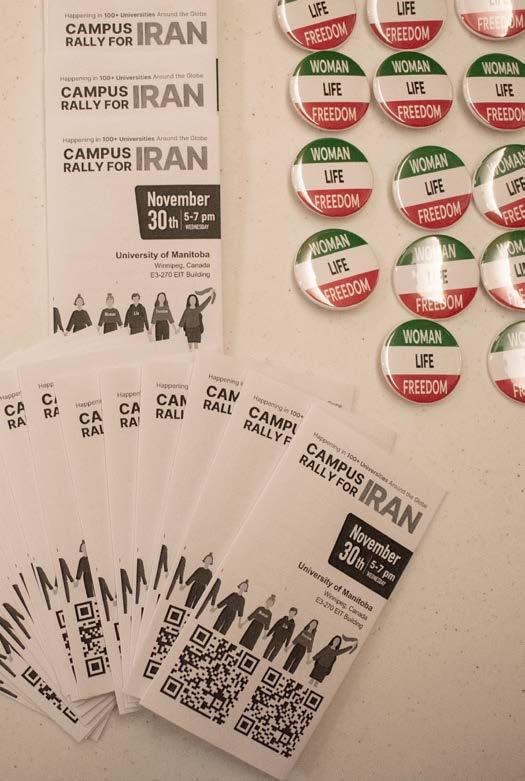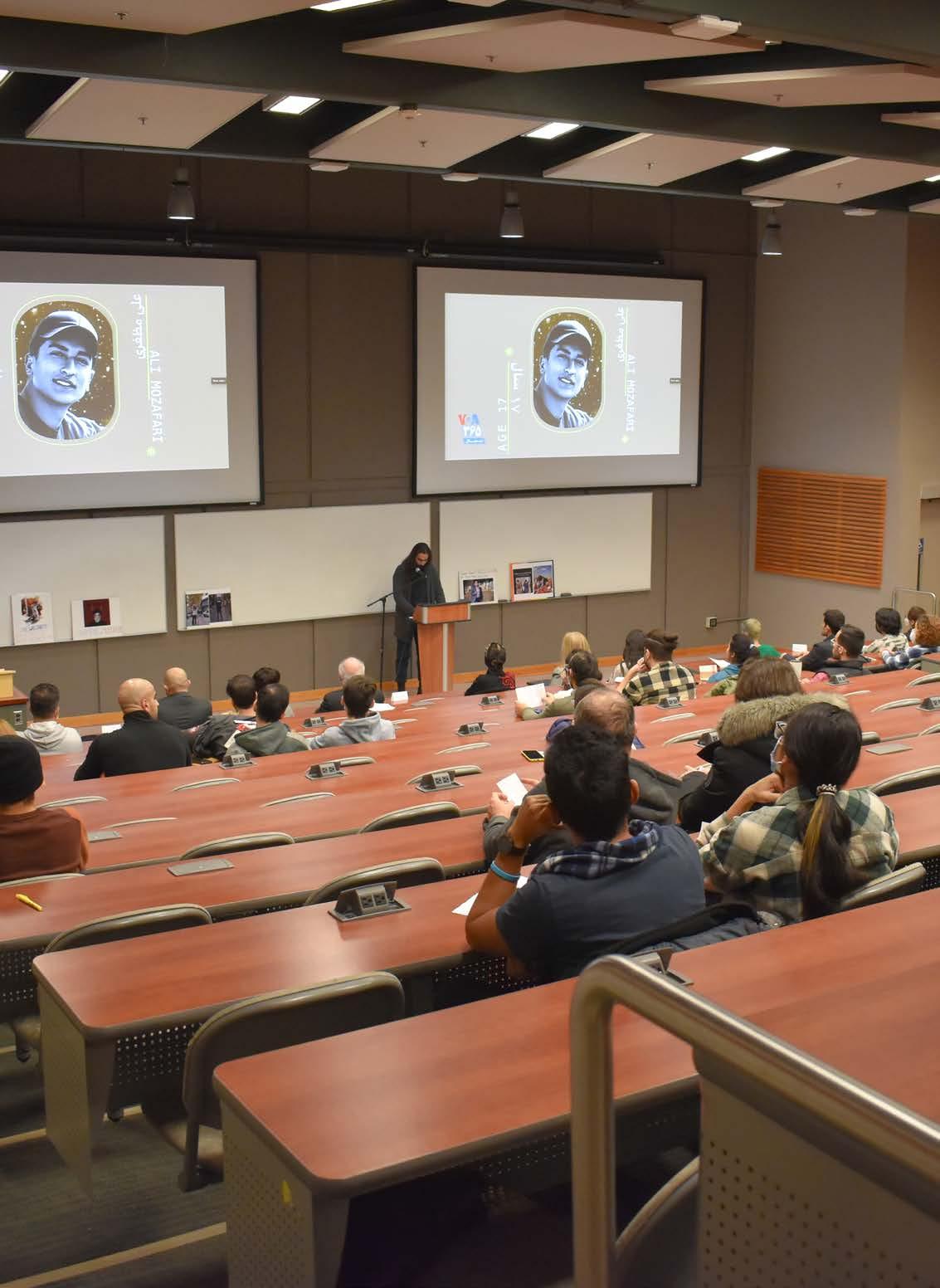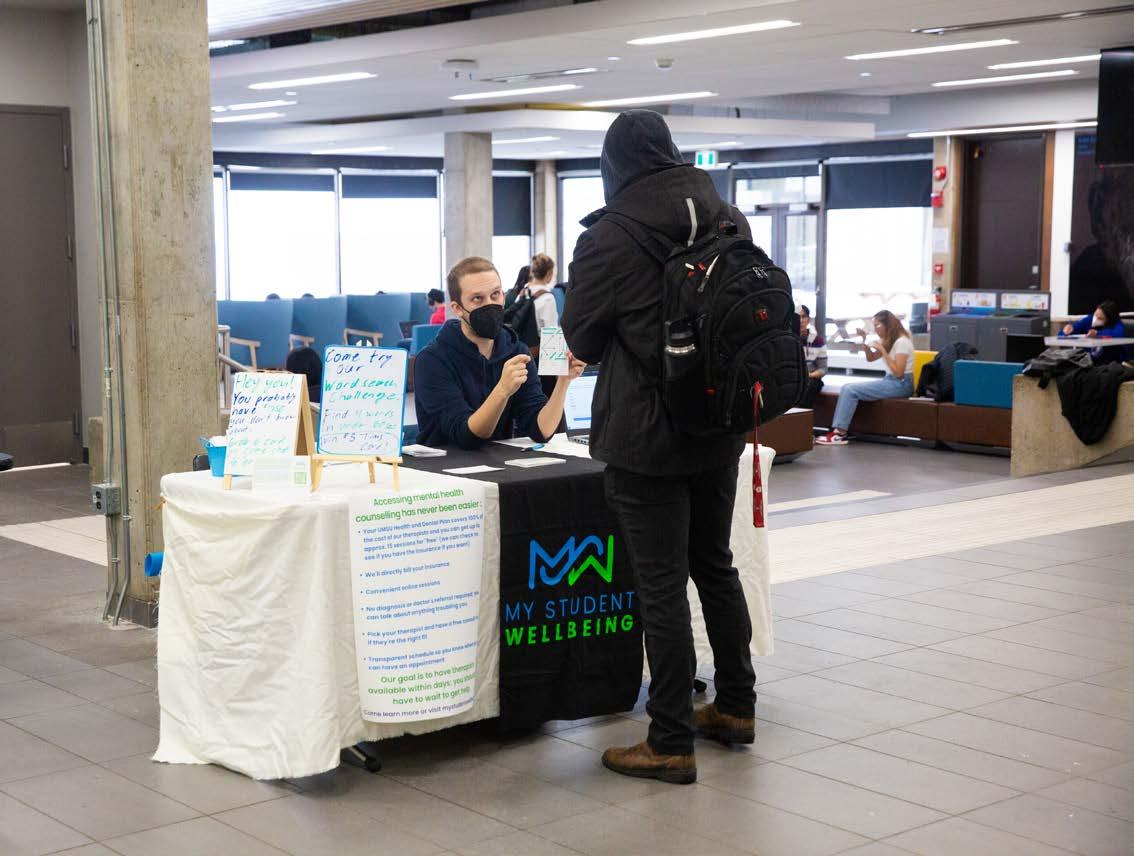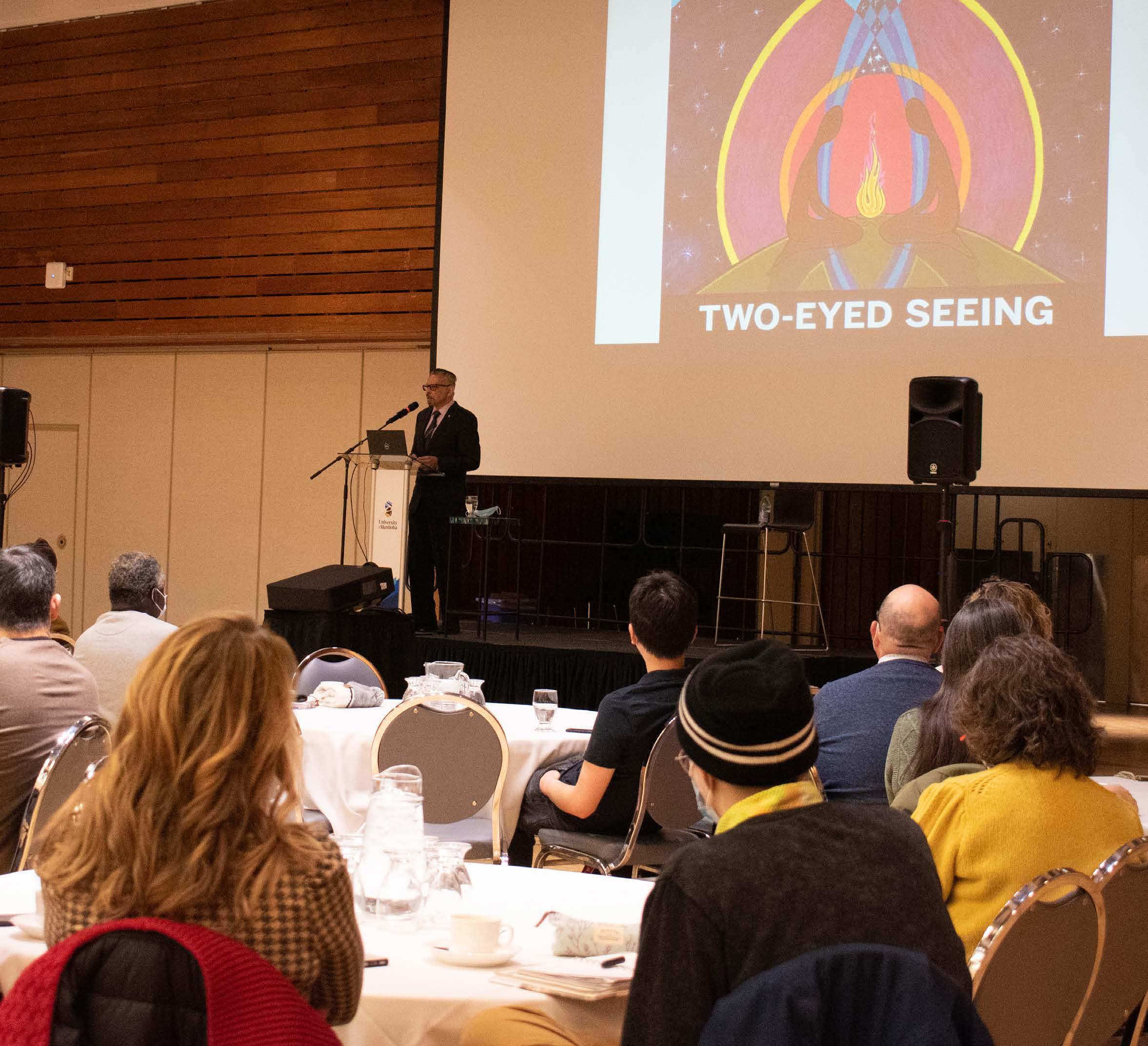
9 minute read
News pages 3 to
from 7 December 2022
U of M students continue to protest Mahsa Amini’s death
Over 200 universities hold rallies in solidarity with Iranian protestors
Ashley Puchniak, staff
The University of Manitoba Iranian Students’ Association (UMISA), along with over 200 universities across the globe, have been participating in demonstrations of solidarity with Iranians protesting the killing of 22-yearold Mahsa Amini. The U of M rally was held on Nov. 30, which marked 75 days since Amini’s death.
Amini died in the custody of Iran’s morality police, who detained her in early September for improperly wearing her hijab.
The incident sparked outrage in Iran and worldwide, with Iranians and other demonstrators around the world taking to the streets in protest.
The movement has adopted the slogan, “woman, life, freedom.”
For Pouya Farokhzad, the president of UMISA, this slogan resonates internationally because women have little freedom in many developing countries.
“Without freedom, you cannot have anything, you cannot even have justice,” he said.
“I think it’s a chant that all people around the world could relate [to], and as I said, it’s not a matter of a region even, it’s a matter of the whole world,”
Farokhzad said that the idea for this series of rallies originated at universities in the United States, and soon spread to other schools in Canada and overseas.
He explained that the uprising in Iran has affected U of M’s Iranian students deeply, as many have loved ones living under the country’s “brutal regime.”
Nazanin Roshanshah, an Iranian PhD student at U of M, said that spreading awareness about Amini’s death is important, as many in Iran “don’t have any voice” because the government has restricted internet access, and those who try to speak out are often censored.
She emphasized that due to the Iranian government’s violent crackdown on protests, it is important for the world to show its support for the people of Iran.
“Be [the] Iranian voice, take action.”
To find more information and support, visit UMISA’s webpage or social media platforms.
news@themanitoban.com

My Student Wellbeing provides mental health resources
Online service helps students make timely appointments, manage costs
Alicia Rose, staff
As exam time rolls around, students may experience higher levels of stress. This season, another resource is available in the form of My Student Wellbeing, an online platform that can help U of M students access private mental health therapists.
Tyler Phill, founder and CEO of the company, explained how on the My Student Wellbeing website, students can get their insurance checked to see what they have covered.
On the website, students can also browse the clinician directory, where they are able to connect with a therapist of their choice. From there, students can book a free 10-minute consult call with a selected therapist to see if they are a good fit.
Under the UMSU health and dental plan, students have up to $1,250 in coverage for services with a mental health practitioner of their choosing.
The services covered include licenced clinical psychologists, counsellors, psychotherapists or an individual with a master’s in social work.
For students enrolled in the UMSU health and dental plan, My Student Wellbeing can directly bill their student insurance.
Once U of M students approach their $1,250 limit, My Student Wellbeing can notify students and suggest alternative options for payment.
Students who are not under the UMSU health and dental plan can still use the service, but may need to pay out of pocket and bill their insurance themselves.
Online therapy sessions through My Student Wellbeing are conducted through a program called Jane, which ensures privacy and security between the therapists and their clients.
Jane also has a calendar where students can see a therapist’s availability, book their appointment and set up a reminder service that works best for them.
Phill explained that he started My Student Wellbeing after working in social work for about five years. During this time, he found himself wanting a role in an organization where he could make a systemic change that would help frontline staff and provide better services for clients.
“I provided counselling to clients myself and I loved the work, and I loved seeing people grow and improve and change their lives in that way, but I wanted to impact organizations in a larger way,” Phill said.
He returned to the University of Manitoba in 2017 to pursue a master’s degree in business administration, with the goal of eventually working for a social service organization. However, after seeing that those around him were unsure of what mental health services to use, he looked into the university’s insurance plan and discovered that he had insurance coverage.
“If I wasn’t just curious one day and looked into it, I probably would never have known that I had this coverage,” he said. “I just paid the fee in my tuition and never really thought about it.”
Phill realized that many other students were probably unaware of the coverage they had, and he also saw a need for more accessible mental health services. He began thinking of what he could do to try address these issues, and as

staff / photo / Ebunoluwa Akinbo
his confidence and knowledge of business grew, he started working on the project.
He explained that the COVID-19 pandemic helped him come up with the idea of creating a virtual counselling and therapy practice that students could use with their insurance plan.
Phill said that his goal for the organization is to have therapists available within 24 hours for appointments with students who need them.
My Student Wellbeing is also looking to hire students from the U of M in the near future. Phill noted that providing students with proper work experience before graduation is another way of looking after their well-being.
He said that so far, he has received positive feedback from students and therapists alike.
More information on My Student Wellbeing can be found on the My Student Wellbeing website, or on its Instagram page.
news@themanitoban.com
Research & Technology
Mario Pinto seeks to unify multiple research disciplines
Robert Moshe Thompson, staff
The word “polymathy” was first used in the title of a work in 1603 by philosopher Joannes Wower. It refers to encyclopedic knowledge that encompasses many fields.
A person who has such knowledge is known as a “polymath.”
Mario Pinto, the U of M’s new vice-president research and international, firmly believes in the power of merging multiple disciplines.
“In principle, if you bring disciplines together, you can do this far-out stuff,” he said. “But it’s a matter of having the experts in the different disciplines, and having them all play in the same sandbox.”
Before coming to the U of M, Pinto worked at Griffith University in Australia as deputy vice-chancellor research. During his time there, he oversaw several clinical trials which required co-ordination between experts in different fields.
Some of these trials used 3D printing and modelling to solve complex medical problems. Pinto’s team had to bring together engineers, computer scientists and AI specialists to work with surgeons.
Before performing surgery, these specialists would create models of patients that Pinto described as “digital twins.” The surgical team would then be able to practice on the twin before operating on the patient. This clinical trial used the same strategy to perform complex pediatric hip procedures. After treating 20 children, the trial found that the need for repeat surgeries was reduced significantly.
This technique was also used in a trial that sought to treat aneurysms in stroke victims. An aneurysm is an abnormal expansion of a blood vessel that can rupture and cause serious complications.
Since no two aneurysms are exactly alike, having a digital model of the enlarged blood vessel gave surgeons the chance to fine-tune their technique before the operation.
Pinto has also been involved in projects that require a collaboration between the arts and sciences.
While working at Simon Fraser University, he was a leader in an interdisciplinary study of the evolution of human culture. The project brought together various experts such as anthropologists, evolutionary biologists and even economists to work
staff / photo / Faith Peters

— Mario Pinto, U of M vice-president research and international
together on the research.
Pinto has been merging the arts and sciences since well before university. His relatives on his mother’s side were heavily involved in artistic pursuits such as music, poetry and theatre.
Pinto added that his maternal great-grandfather had one of the first printing presses in Sri Lanka, the country where he grew up.
Pinto’s father’s relatives, on the other hand, were involved mostly in the sciences. His grandfather and great-grandfather were both apothecaries, another term for a pharmacist. His father was also a forensic chemist.
Because of his paternal family history, Pinto considers himself to be a fourth-generation chemist.
Although Pinto wanted to maintain his dual interest in the arts and sciences, he had to choose one or the other when he went to university.
During his undergraduate degree, Pinto switched his topic of study multiple times. He entered various majors such as musical theatre, math and the live sciences.
Eventually, Pinto graduated with a degree in chemistry, but he was not done mixing disciplines. While pursuing his PhD at Queen’s University, he also worked with supervisors at the University of Toronto and Dalhousie University.
Since all three of his supervisors had different specialties, Pinto was able to assemble a thesis that reflected his diverse work experience.
Although his formal educational background is chemistry, Pinto continues to engage with the arts. He often uses art to depict scientific concepts.
Diversity of many kinds has always been a theme in Pinto’s life. In Sri Lanka, he grew up being exposed to people of many different backgrounds and religions from a young age.
Pinto’s own origins are also diverse. His ancestors are a mix of Sri Lankan, Portuguese and Goan. Being exposed to multiple cultures taught him to be open to different philosophies and ways of knowing.
He has always been interested in international relations and has spent many years working abroad. His research has taken him to Europe, Latin America and the Caribbean.
Pinto said that having a worldwide network of researchers brings many of the same benefits as interdisciplinary collaboration.
“It’s the same principle,” he explained. “You have very different perspectives. People have been trained differently, they’re exposed to different cultural norms and what drives them is very different. And they ask very different questions. So one can learn a lot from that.”
research@themanitoban.com





